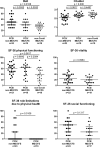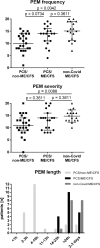A prospective observational study of post-COVID-19 chronic fatigue syndrome following the first pandemic wave in Germany and biomarkers associated with symptom severity
- PMID: 36042189
- PMCID: PMC9426365
- DOI: 10.1038/s41467-022-32507-6
A prospective observational study of post-COVID-19 chronic fatigue syndrome following the first pandemic wave in Germany and biomarkers associated with symptom severity
Erratum in
-
Author Correction: A prospective observational study of post-COVID-19 chronic fatigue syndrome following the first pandemic wave in Germany and biomarkers associated with symptom severity.Nat Commun. 2022 Oct 12;13(1):6009. doi: 10.1038/s41467-022-33784-x. Nat Commun. 2022. PMID: 36224219 Free PMC article. No abstract available.
Abstract
A subset of patients has long-lasting symptoms after mild to moderate Coronavirus disease 2019 (COVID-19). In a prospective observational cohort study, we analyze clinical and laboratory parameters in 42 post-COVID-19 syndrome patients (29 female/13 male, median age 36.5 years) with persistent moderate to severe fatigue and exertion intolerance six months following COVID-19. Further we evaluate an age- and sex-matched postinfectious non-COVID-19 myalgic encephalomyelitis/chronic fatigue syndrome cohort comparatively. Most post-COVID-19 syndrome patients are moderately to severely impaired in daily live. 19 post-COVID-19 syndrome patients fulfill the 2003 Canadian Consensus Criteria for myalgic encephalomyelitis/chronic fatigue syndrome. Disease severity and symptom burden is similar in post-COVID-19 syndrome/myalgic encephalomyelitis/chronic fatigue syndrome and non-COVID-19/myalgic encephalomyelitis/chronic fatigue syndrome patients. Hand grip strength is diminished in most patients compared to normal values in healthy. Association of hand grip strength with hemoglobin, interleukin 8 and C-reactive protein in post-COVID-19 syndrome/non-myalgic encephalomyelitis/chronic fatigue syndrome and with hemoglobin, N-terminal prohormone of brain natriuretic peptide, bilirubin, and ferritin in post-COVID-19 syndrome/myalgic encephalomyelitis/chronic fatigue syndrome may indicate low level inflammation and hypoperfusion as potential pathomechanisms.
© 2022. The Author(s).
Conflict of interest statement
The authors declare no competing interests.
Figures





References
-
- WHO. Living guidance for clinical management of COVID-19: living guidance, 23 November 2021. World Health Organization, Available online at: https://www.who.int/publications/i/item/WHO-2019-nCoV-clinical-2021-2 (2021).
-
- Alwan NA. A negative COVID-19 test does not mean recovery. Nature. 2020;584:170. - PubMed
-
- Williams FMK, Muirhead N, Pariante C. Covid-19 and chronic fatigue. BMJ. 2020;370:m2922. - PubMed
Publication types
MeSH terms
Substances
LinkOut - more resources
Full Text Sources
Medical
Research Materials

